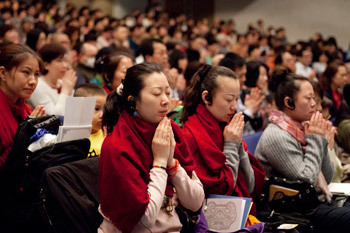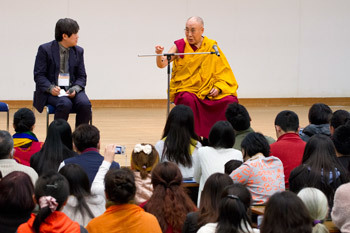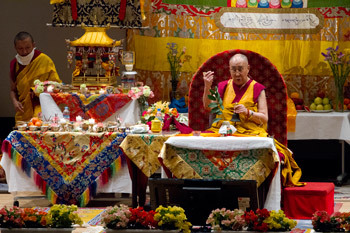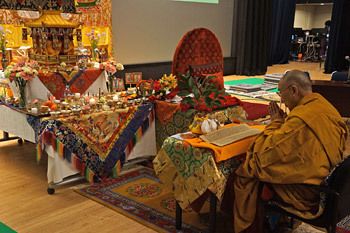Tokyo, Japan, 13 April 2015 - The Showa Joshi Women’s University Memorial Hall was empty this morning when His Holiness the Dalai Lama arrived. He took a seat facing the small pavilion containing the mandala and a thangka of 1000 armed Avalokiteshvara to begin preparations for the empowerment he was to give. During the hour that these took the hall steadily filled.
Today’s proceedings began with a recitation of the Heart of Wisdom Sutra in Japanese. His Holiness explained what he was planning to do:
“We’ll go through the empowerment first this morning. An empowerment is necessary if your want to practise tantra. Although other tantric traditions employ similar techniques, what distinguishes Buddhist tantric practice is that it is done in the context of an understanding of emptiness and the awakening mind. It is also an opportunity to employ subtler levels of consciousness, the most subtle being the primordial mind of clear light. This is what is sometimes referred to as Buddha nature. It is the extraordinary mind that is eventually transformed into the body of the Buddha at enlightenment.
“The tantric vehicle or vajrayana is also known as mantrayana, which means the vehicle that protects the mind. It protects the mind from ordinary appearance involving the practitioner’s visualizing him or herself in the form of a deity.”
His Holiness also explained the significance of the vajra and bell he was holding. He said the vajra represented deity yoga, while the bell represented understanding of emptiness. For visualizing of yourself as a deity to be effective it has to be qualified by an understanding of the emptiness of intrinsic existence. The vajra and bell are employed together to show that deity yoga and wisdom are indivisible.

|
Members of the audience attending His Holiness the Dala Lama's teaching at Showa Joshi Women’s University in Tokyo, Japan on April 13, 2015. Photo/Tenzin Jigmey
|
Action tantra defines the disciples qualified to engage in tantric practice as bhikshus and bhikshunis and those who hold lay ordination. Therefore, His Holiness said he would offer lay ordination for those who wished to take it. He explained the five precepts pledging to avoid killing, stealing, lying, sexual misconduct and the use of intoxicants. He advised that individuals are free to decide how many and which of these precepts they can take and keep. He based the ceremony for taking these vows on a threefold recitation of a basic verse for taking refuge in the Buddha, Dharma and Sangha. He followed this with an opportunity for disciples to generate the awakening mind.
He then led the audience in taking the Bodhisattva vows on the basis reciting the simple verse:
To the Three Jewels I go for refuge,
All misdeeds I specifically confess.
I rejoice in the virtues of wandering beings
And make a wish to attain the enlightenment of a Buddha.
He remarked that it would be helpful to recite this verse every day and to recall it when we come to die.
Once His Holiness had completed the Avalokiteshvara empowerment he said that it would be good to recite the mantra, but that the commitment was to help others if you can, and even if you can’t to make an effort to avoid harming them.

|
His Holiness the Dalai Lama speaking to a group of Chinese Buddhists during the lunch break of his teachings at Showa Joshi Women’s University in Tokyo, Japan on April 13, 2015. Photo/Tenzin Jigmey
|
During the lunch break His Holiness met with a group of Chinese Buddhists. He told them that since there are estimated to be 400 million Buddhists in China, it is a Buddhist country. He recalled the many temples he saw during his visit in 1954-55. He remarked that the communist authorities have tried to eradicate religion and failed. Religion is a source of solace and while many religious traditions are rooted in faith, what stands out about Buddhism is its use of reasoning.
He told them that dialogue he has been holding with scientists for more than 30 years has been mutually beneficial. He has learned, for example, that the cosmology described in the Abhidharma texts is inaccurate and he accepts the scientific account of the universe in which we live. At the same time scientists are taking great interest in what they can learn of the workings of the mind and emotions from Buddhist texts.
He praised the Nalanda tradition’s rigorous approach to knowledge. He recommended reading and listening to explanations, thinking about what you have read or heard to gain conviction in it and then familiarizing yourself with what you have understood in meditation. He stressed the importance of study and analysis, pointing out that simply reciting the name of Amitabha is not enough.
His Holiness began the afternoon session by giving a permission of Avalokiteshvara Khasarpani, a one faced two armed form, depicted at ease, resting in the nature of the mind. He then gave a concise reading of the middle volume of the ‘Stages of Meditation’, touching on several of the topics it discusses, such as what the mind is and how to train it. Compassion, which is the catalyst that activates the awakening mind of bodhichitta, is based on the recognition that although sentient beings don’t want suffering, they continually create its causes.

|
His Holiness the Dalai Lama during the afternoon session of his teachings at Showa Joshi Women’s University in Tokyo, Japan on April 13, 2015. Photo/Tenzin Jigmey
|
He explained what is implied by the word beginningless when we say that sentient beings have been caught in cyclic existence for beginningless time. The substantial cause of consciousness is another consciousness and it is the continuum of moments of consciousness that is beginningless. He touched on the nature of suffering, noting that while the basic pain of what we acknowledge as suffering is obvious, what is described as the suffering of change and the all-pervasive suffering of conditioning we often mistake for pleasure.
In describing how to develop special insight the text elucidates the need to develop a calmly abiding mind. It explains the steps for developing this by, for instance, concentrating on a visualized image of the Buddha, warning of the pitfalls of laxity and excitement on the way. Transcendent special insight focuses on the emptiness of intrinsic existence. It is achieved by applying the concentration of the calmly abiding mind to the understanding that has been achieved through analytical meditation. This leads the practitioner to enter the paths of accumulation and preparation. Reaching the path of seeing also entails reaching the first of the ten bodhisattva grounds, which unfold during the path of meditation and no more learning.
His Holiness concluded the session with a short account of the ‘Three Essential Moments’ by Gendun Gyatso, the 2nd Dalai Lama. It is based on a teaching originating with the Indian Avalokiteshvara adept, Maitriyogi. It describes practices to do in life, at the time of death and in the intermediate state. The practices to do in life include visualizations of Avalokiteshvara and the transformation of all sentient being and meditation on the nature of the mind.
 |
A view of the stage at Showa Joshi Women’s
University's Memorial Hall during the second day of His Holiness the
Dalai Lama's teaching in Tokyo, Japan on April 13, 2015.
Photo/Tenzin Jigmey |
The practice for the time of death involved the transference of consciousness into Avalokiteshvara visualized on the crown of the head. This is something the practitioner needs to become proficient at doing, learning to project the consciousness upward while saying ‘hic’. When rehearsing the practice it’s important not to let the consciousness pass through the crown, but to catch it there and bring it back down again with ‘gah, gah’. Another crucial factor is being able to recognise the signs of impending death. His Holiness stated that there are long-term and short-term signs, but also coarse and subtle signs. An accomplished yogi, for example, can read the changes in the flow of breath through the nostrils.
His Holiness explained that key to the practices to be done in the intermediate state is being able to develop an awareness of being in such a state. He added that much depends on how the practitioner has done the practice while alive.
“In Japan time is strictly observed and we’ve already overrun so we’ll have to stop here,” His Holiness laughed. “Although we weren’t able to go through the texts word by word, you should be able to review them again yourselves and discuss what you learn with your friends. That’s all; thank you all for coming.”
Tomorrow, His Holiness will fly back to India.

















